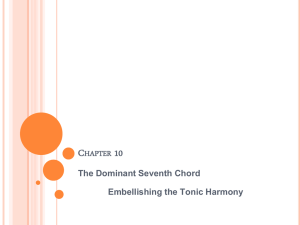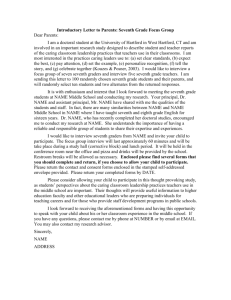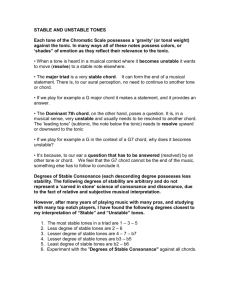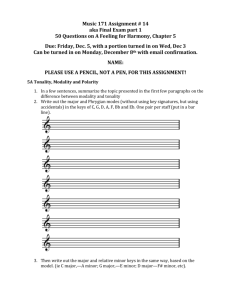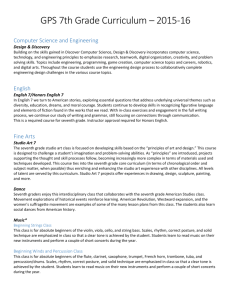ModesAnalysis - Dsapresents.org
advertisement
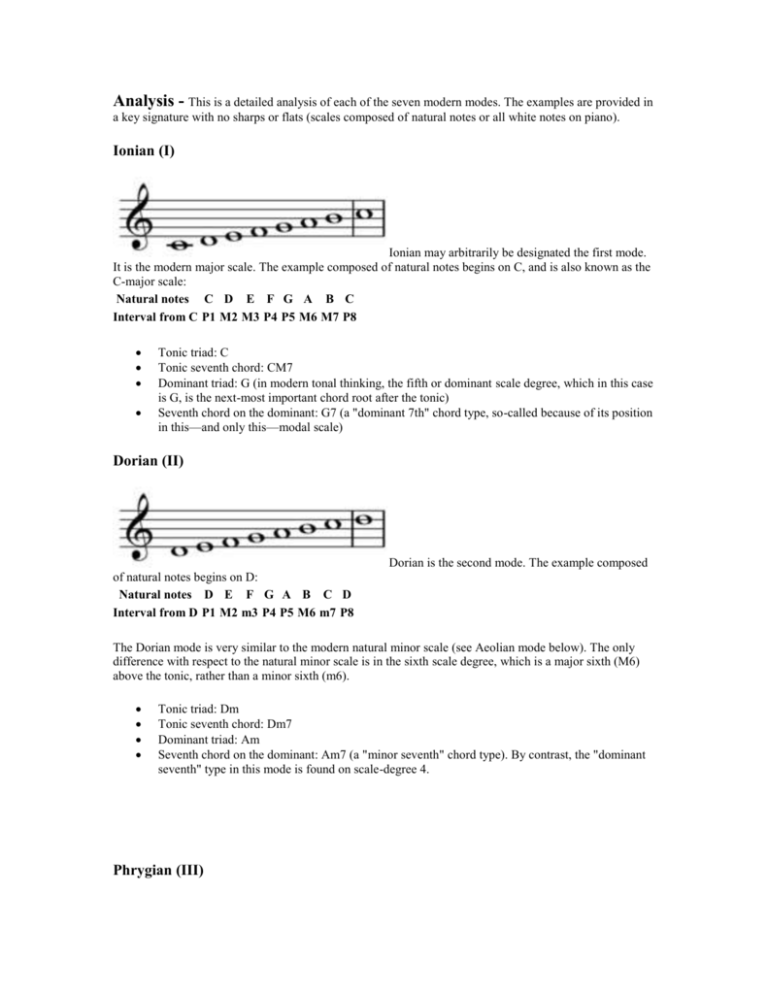
Analysis - This is a detailed analysis of each of the seven modern modes. The examples are provided in a key signature with no sharps or flats (scales composed of natural notes or all white notes on piano). Ionian (I) Ionian may arbitrarily be designated the first mode. It is the modern major scale. The example composed of natural notes begins on C, and is also known as the C-major scale: Natural notes C D E F G A B C Interval from C P1 M2 M3 P4 P5 M6 M7 P8 Tonic triad: C Tonic seventh chord: CM7 Dominant triad: G (in modern tonal thinking, the fifth or dominant scale degree, which in this case is G, is the next-most important chord root after the tonic) Seventh chord on the dominant: G7 (a "dominant 7th" chord type, so-called because of its position in this—and only this—modal scale) Dorian (II) Dorian is the second mode. The example composed of natural notes begins on D: Natural notes D E F G A B C D Interval from D P1 M2 m3 P4 P5 M6 m7 P8 The Dorian mode is very similar to the modern natural minor scale (see Aeolian mode below). The only difference with respect to the natural minor scale is in the sixth scale degree, which is a major sixth (M6) above the tonic, rather than a minor sixth (m6). Tonic triad: Dm Tonic seventh chord: Dm7 Dominant triad: Am Seventh chord on the dominant: Am7 (a "minor seventh" chord type). By contrast, the "dominant seventh" type in this mode is found on scale-degree 4. Phrygian (III) Phrygian is the third mode. The example composed of natural notes starts on E: Natural notes E F G A B C D E Interval from E P1 m2 m3 P4 P5 m6 m7 P8 The Phrygian mode is very similar to the modern natural minor scale (see Aeolian mode below). The only difference with respect to the natural minor scale is in the second scale degree, which is a minor second (m2) above the tonic, rather than a major second (M2). Tonic triad: Em Tonic seventh chord: Em7 Dominant triad: Bdim Seventh chord on the dominant: Bø, a "half-diminished seventh" chord type. By contrast, the "dominant seventh" type in this mode is found on scale-degree 3. Lydian (IV) Lydian is the fourth mode. The example composed of natural notes starts on F: Natural notes F G A B C D E F Interval from F P1 M2 M3 A4 P5 M6 M7 P8 The single tone that differentiates this scale from the major scale (Ionian mode), is its fourth degree, which is an augmented fourth (A4) above the tonic (F), rather than a perfect fourth (P4). Tonic triad: F Tonic seventh chord: FM7 Dominant triad: C Seventh chord on the dominant: CM7, a "major-seventh" chord type. By contrast, the "dominant seventh" type in this mode is found on scale-degree 2. Mixolydian (V) Mixolydian is the fifth mode. The example composed of natural notes begins on G: Natural notes G A B C D E F G Interval from G P1 M2 M3 P4 P5 M6 m7 P8 The single tone that differentiates this scale from the major scale (Ionian mode), is its seventh degree, which is a minor seventh (m7) above the tonic (G), rather than a major seventh (M7). Tonic triad: G Tonic seventh chord: G7 (the "dominant-seventh" chord type in this mode is the seventh chord built on the tonic degree) Dominant triad: Dm Seventh chord on the dominant: Dm7, a "minor-seventh" chord type. Aeolian (VI) Aeolian is the sixth mode. It is also called the natural minor scale. The example composed of natural notes begins on A, and is also known as the A-minor scale: Natural notes A B C D E F G A Interval from A P1 M2 m3 P4 P5 m6 m7 P8 Tonic triad: Am Tonic seventh chord: Am7 Dominant triad: Em Seventh chord on the dominant: Em7, a "minor-seventh" chord type. By contrast, the "dominant seventh" type in this mode is found on scale-degree 7. Locrian (VII) Locrian is the seventh and final mode. The example composed of natural notes begins on B: Natural notes B C D E F G A B Interval from B P1 m2 m3 P4 d5 m6 m7 P8 The distinctive scale degree here is the diminished fifth (d5). This makes the tonic triad diminished, so this mode is the only one in which the chords built on the tonic and dominant scale degrees have their roots separated by a diminished, rather than perfect, fifth. Similarly the tonic seventh chord is half-diminished. Tonic triad: Bdim or B° Tonic seventh chord: Bm7♭5 or Bø Dominant triad: FM Seventh chord on the dominant: FM7, a major-seventh chord type. By contrast, the "dominant seventh" type in this mode is found on scale-degree 6.

